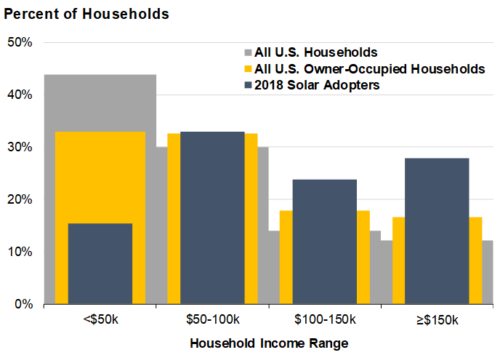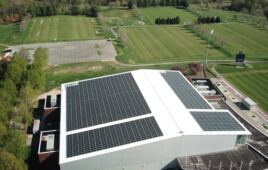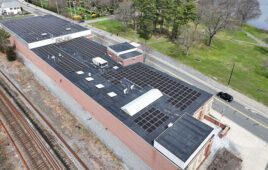A new report by Lawrence Berkeley National Laboratory highlights income trends among residential rooftop solar adopters.
The study is based on address-specific income estimates and other financial metrics for roughly 1.4 million residential rooftop solar adopters across the country, representing the most extensive analysis of this topic to-date. The study describes the income distribution of solar adopters over time and across states and other geographic scales. Though the study posits some broad hypotheses for the observed trends, it aims primarily to serve as a foundational resource for market participants and other researchers who seek to explore these topics in further depth.
Key findings from the study include the following:
- Solar adopters span all income ranges, including low-to-moderate (LMI) households. As shown in Figure 1, 15% of 2018 solar adopters have household incomes <$50k, 33% are between $50-100k, 24% are between $100-150k, and the remaining 28% are ≥$150k. Using one common definition of LMI, 15% of 2018 adopters are below 80% of their respective Area Median Income (AMI), while 30% are below 120% of AMI.
- Solar-adopter incomes skew high relative to the broader population, though less so when compared to just owner-occupied households (OO-HHs), and also less so when compared to other households in the same local area (e.g., county or census tract). For example, 18% of 2018 solar adopters have incomes below the national median for all households, while 30% are below the national median for OO-HHs, and 38% are below the median income for OO-HHs in the same census tract.
- The degree of disparity varies significantly across states and local markets. Among individual states, typically anywhere from 25-50% of 2018 solar adopters have incomes below the state median for OO-HHs, and a similar range applies across most counties as well. A total of 3 states and 42 counties in the dataset exhibit “income parity,” where at least half of all 2018 solar adopters have incomes below the corresponding median for OO-HHs.
- Solar adoption has been gradually migrating toward lower income ranges over time, reflecting both a broadening and a deepening of U.S. solar markets. For example, households with incomes <$100k grew from 39% of solar adopters in 2010 to 48% in 2018, while those with incomes ≥$200k dropped from 26% to 16%. Similar trends are evident within most individual states and counties as well.
- Solar adopters also skew high in terms of home value and credit score, relative to the broader population. Among all 2018 solar adopters, 27% have home values below their respective county median, while 35% have credit scores below the median. As with the income trends, however, these numbers have been rising over time as adoption rates increase among households with below-median home values and credit scores.
The report, published in slide-deck form along with an accompanying set of online data visualizations, is available at https://solardemographics.lbl.gov.
The authors will also host a webinar highlighting key findings from this study on March 10, 2020 at 11:00 AM Pacific/2:00 PM Eastern. Register for the webinar here: https://lbnl.zoom.us/webinar/register/WN_WocYzU-BR8S4UaK1XYMuHg
News item from the Lawrence Berkeley National Laboratory





I would like to push back on the approach of this article for another reason:
1. Simply, if systems for one and two family dwellings are smaller, more people may purchase a solar energy system they can afford. I encourage small systems because it’s better than nothing.
2. However, many contractors are hesitant to install only one or two modules because it depends on the size of the job and the client’s ability to pay for the work. Simply, a contractor makes more on a larger job.
When I’m shopping, I see many sale priced items as BOGO (Buy One Get One Free). I hope the folks in the solar and storage industry consider this as an option?
Solar adoption for the ‘so called’ LMI households are the sign the moronic claim, that solar PV is for “rich people”, is a prejudiced attempt to rationalize not spending the money on solar PV and not taking responsibility for one’s daily energy use.
In 1920’s it was the automotive assembly line that enabled Ford for one to crank out cars at a rate that the average Joe could afford. In the 2020’s solar PV adoption is allowing a swelling of solar PV panels on the marketplace. Within the next 10 years utilities will be looking at upgrading their generation facilities and will begin replacing old technology solar PV panels with the latest technology solar PV panels. These utilities might also replace the old racking system with new tracking racking systems. There will be a flood of cheap, very usable solar PV panels available in the used market place. IF solar PV panel prices keep dropping until bottom is reached, then industry saturation will take over and a used market with panels by the pound will appear. Would it be possible to get used and still highly producing solar PV panels for $0.05/watt?. I believe it could happen and sooner than later. What about ground racking systems per pound? In this very instance, there should be no reason a rural area, farm, dairy, vineyard or just a “country home” shouldn’t be able to have their own solar PV system.
Even with the rote electric utility attempts to dilute the value of a personal solar PV system, by creating tiered electric rate programs, TOU rate spiking programs and demand charges, the LMI crowd understands as electricity rates go up, having their own generation system will offset the electric rate costs and save them money for things like home owners insurance, property taxes, groceries or even a trip to “Disney World”.
This is exactly what “disruptive technology” does, it gains momentum, and rolls over philosophical, monetary (ROI), political (we need piles of fuel to insure electrical generation and protect (national security). As the technology ‘rolls along’ it crushes the luddite excuses and “If it ain’t broke don’t fix it”, folkisms. The realization, that one can pay it forward and install their own energy generation system that can save them enough money from their ‘budget’ each year to pay for something else is an ‘utterance’ that cannot be unheard and a fact that cannot be unwitnessed.